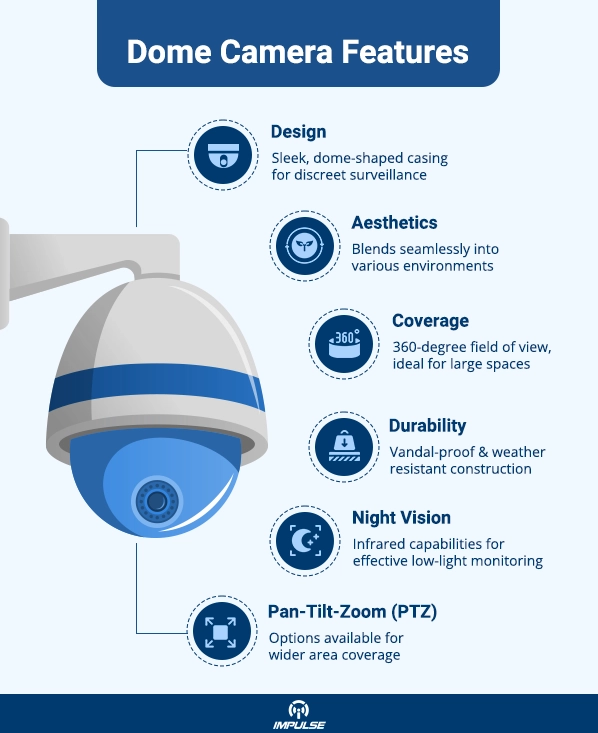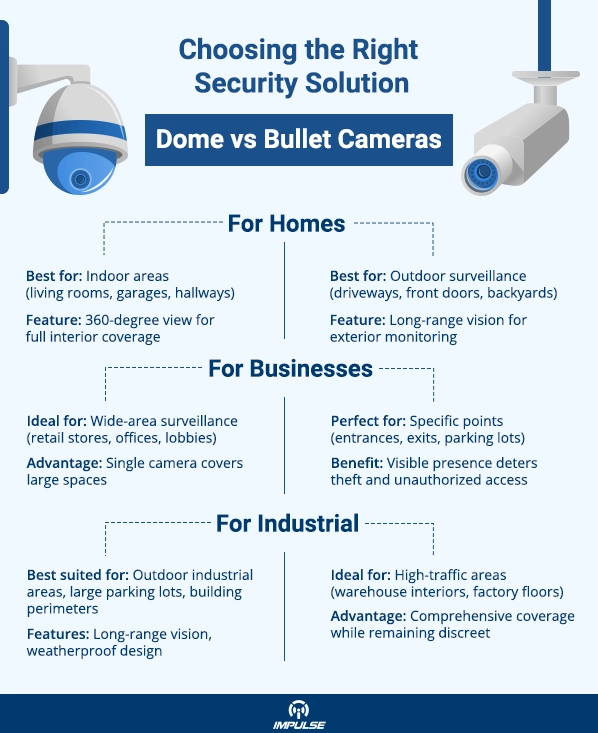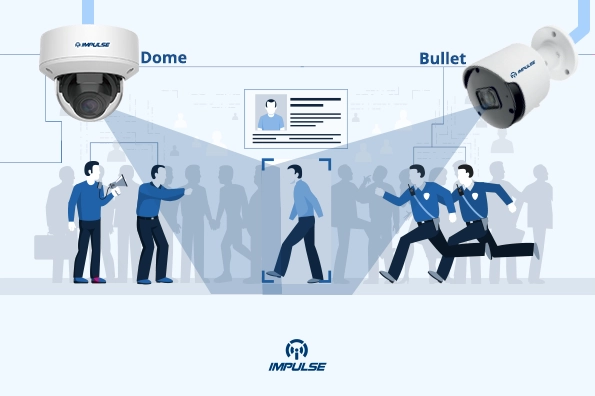Choosing the right security camera is critical for effective surveillance, whether you’re securing a business premise, residential property, or an industrial site. With the variety of options available, two popular types stand out—dome cameras and bullet cameras. Each offers unique features and benefits, but knowing which camera is best for your needs is essential for creating an efficient security system.
In this blog, we’ll dive deep into the dome vs. bullet camera debate to help you make an informed decision. We’ll cover their design, key features, applications, and which is better suited for different environments. For business owners and system integrators, choosing between dome security cameras and CCTV bullet cameras could mean the difference between an effective security setup and one that falls short. Let’s explore both options in detail.
What Are Dome Cameras?
Dome cameras are named after their dome-shaped casing, which gives them a sleek and discreet look. Their unobtrusive design makes them ideal for environments where aesthetics and subtlety are key. Dome security cameras are typically mounted on ceilings or walls, blending seamlessly into various surroundings.
Key Features
- 360-degree coverage: Dome cameras offer a comprehensive view of large spaces, capturing a broad area with a single device. This makes them ideal for monitoring expansive rooms, warehouses, or open office layouts.
- Vandal-proof and weather-resistant: The sturdy construction of dome cameras provides excellent protection against tampering and harsh environmental conditions. Their robust design ensures continued functionality even in challenging outdoor settings or high-traffic areas prone to potential vandalism.
- Infrared and night vision capabilities: Equipped with advanced infrared technology, dome cameras deliver clear, high-quality footage even in low-light or complete darkness. This feature ensures round-the-clock surveillance, maintaining security standards regardless of lighting conditions or time of day.
- Discreet appearance: The compact and unobtrusive design of dome cameras allows them to blend seamlessly into various environments. This subtle presence helps maintain a professional atmosphere while still providing robust security coverage.

Applications
Dome cameras are typically used indoors, offering discreet surveillance in various settings. Here are some common applications:
- Offices: Perfect for monitoring workspaces without being too obvious. Their unobtrusive design allows for comprehensive surveillance of open-plan offices, meeting rooms, and reception areas without making employees feel uncomfortable.
- Retail Stores: Provides broad coverage in showrooms or checkout areas. Dome cameras can effectively monitor customer behavior, prevent shoplifting, and ensure staff safety across large retail spaces.
- Homes: Ideal for monitoring entryways or large living spaces. Homeowners can keep an eye on high-traffic areas like foyers, living rooms, or kitchens without compromising the aesthetic appeal of their interior design.
- Hotels and Hospitality: Excellent for monitoring lobbies, corridors, and common areas while maintaining a professional and welcoming atmosphere for guests.
Advantages
- Discreet design: Their sleek look ensures they don’t stand out, making them suitable for environments where appearances matter. This low-profile design is particularly beneficial in upscale establishments or areas where visible security measures might be off-putting.
- Wide field of view: With pan-tilt-zoom (PTZ) options, dome cameras can cover larger areas with fewer cameras. This capability allows for dynamic surveillance, adjusting to monitor specific areas of interest as needed, which can be especially useful in large, open spaces.
- Vandal-resistant: Many dome cameras come with sturdy, impact-resistant casings, making them less susceptible to damage or tampering. This feature is particularly valuable in public spaces or areas prone to potential vandalism.
Disadvantages
- Complex installation: Dome cameras can be trickier to install than bullet cameras, especially on ceilings. The process often requires careful planning to ensure proper coverage and may necessitate professional installation, potentially increasing overall costs.
- Limited zoom: Compared to specialized long-range cameras, dome cameras may have lower zoom capabilities. This limitation can make them less suitable for detailed surveillance of distant objects or areas, which might be a concern in large outdoor spaces or when specific long-range monitoring is required.
- Potential for IR reflection: In some cases, the dome’s casing can cause infrared light to reflect, potentially affecting the quality of night vision footage. This issue may require careful positioning or the use of specific anti-reflection coatings to mitigate.
What Are Bullet Cameras?
Bullet cameras have a cylindrical shape and are usually mounted on walls or poles. Unlike dome cameras, CCTV bullet cameras are designed to be more noticeable, which can act as a visual deterrent to potential intruders.
Key Features
- Narrow, focused field of view: Ideal for long-range surveillance.
- Built-in infrared and night vision: Bullet cameras are designed to work in both day and night conditions.
- Weatherproof design: Many bullet cameras are built to withstand outdoor conditions, making them a popular choice for external surveillance.

Applications
Bullet cameras are typically used outdoors, offering robust surveillance in various settings. Their design and capabilities make them particularly suitable for:
- Driveways: Bullet cameras excel at monitoring vehicle traffic, providing clear footage of cars entering and leaving the property. This makes them invaluable for both residential and commercial settings where vehicle security is a priority.
- Parking lots: With their focused field of view, bullet cameras deliver sharp, detailed images of specific areas within parking lots. This precision is crucial for identifying suspicious activities, monitoring parking spaces, and ensuring the safety of parked vehicles.
- Entrances and exits: Bullet cameras are ideal for monitoring key entry and exit points, offering a clear view of individuals coming and going. This targeted surveillance is essential for detecting and deterring unauthorized access, making them a popular choice for businesses and high-security areas.
Also Read: Top 5 Outdoor Network Cameras for Businesses: Deter Crime and Monitor Property
Advantages
- Easy installation and adjustment: Bullet cameras are designed for straightforward mounting and positioning. Their simple bracket-based installation allows for quick setup and easy adjustments, making them a preferred choice for DIY enthusiasts and professional installers alike. This ease of use can significantly reduce installation time and costs.
- Effective visual deterrent: The prominent and recognizable shape of bullet cameras serves as a powerful visual deterrent to potential criminals. Their visible presence can significantly reduce the likelihood of break-ins, vandalism, and other criminal activities, making them an essential component of a comprehensive security strategy.
- Superior long-range coverage: Bullet cameras are engineered to provide detailed surveillance over extended distances. Their design allows for the use of larger lenses, enabling them to capture clear, high-resolution images of distant objects or areas. This makes them particularly useful for monitoring large outdoor spaces, perimeters, and entry points from a distance.
Disadvantages
- Increased vulnerability to tampering: Due to their protruding design and often accessible mounting locations, bullet cameras can be more susceptible to tampering or vandalism. Potential intruders may attempt to reposition, cover, or damage the cameras, potentially compromising the security system. This vulnerability necessitates careful placement and may require additional protective measures in high-risk areas.
- Limited area coverage compared to dome cameras: While bullet cameras excel at long-range, focused surveillance, they typically have a narrower field of view compared to dome cameras. This limitation means that multiple bullet cameras might be necessary to achieve the same coverage as a single, strategically placed dome camera. This can potentially increase the overall cost and complexity of the security system, especially in large or open spaces that require comprehensive monitoring.
Key Differences Between Dome and Bullet Cameras
To help you choose between dome and bullet cameras, here are some key differences to consider:
1. Field of View
- Dome Cameras: Offer 360-degree surveillance, making them ideal for monitoring large, open areas.
- Bullet Cameras: Focus on a specific point, providing a narrower, long-range view that’s better for targeted areas.
2. Durability
- Dome Cameras: Typically more vandal-resistant due to their enclosed design, making them harder to tamper with.
- Bullet Cameras: While they are weatherproof, bullet cameras are more vulnerable to tampering because they are easier to reach and manipulate.
3. Installation Flexibility
- Bullet Cameras: Easier to install and reposition, especially for monitoring specific areas like gates or entrances.
- Dome Cameras: Offer more versatility in placement, as they can be mounted on walls or ceilings for broader coverage.

4. Visibility and Deterrence
- Bullet Cameras: Their visibility can deter potential intruders before they even act.
- Dome Cameras: Less noticeable and discreet, making them ideal for environments where you don’t want to alert people to the presence of a camera.
5. Price
The cost of both camera types can vary depending on additional features like infrared, night vision, or PTZ capabilities. However, the complexity of installing dome cameras may add to the overall cost of the security setup.
Also Read: Choosing Between NVR and DVR for Your Security Camera System
Use Cases: Which Camera is Best for Your Needs?
Certainly! I’ll create an infographic post outline for the topic “Use Cases: Which Camera is Best for Your Needs?” based on the information provided. Here’s a suggested structure for the infographic:

For Homes
- Dome Cameras: Best suited for indoor areas such as living rooms, garages, and hallways. Their 360-degree view allows for full coverage of the home’s interior.
- Bullet Cameras: The best choice for outdoor surveillance, including monitoring driveways, front doors, and backyard areas. Bullet cameras’ long-range vision makes them ideal for this purpose.
For Businesses
- Dome Cameras: These cameras are excellent for wide-area surveillance in retail stores, offices, and lobbies, where a single camera can cover a large space.
- Bullet Cameras: Ideal for monitoring specific points such as entrances, exits, and parking lots. Bullet cameras’ visible presence can also deter theft and unauthorized access.
For Industrial or Outdoor Spaces
- Bullet Cameras: With their long-range vision and weatherproof design, bullet cameras are perfect for securing outdoor industrial areas, large parking lots, and building perimeters.
- Dome Cameras: In high-traffic areas such as warehouse interiors or factory floors, dome cameras provide comprehensive coverage while being discreet.
Also Read: Securing Your Investment: Implementing Security Cameras on Construction Sites
Key Considerations for Selecting Between Dome and Bullet Cameras
1. Installation Environment and Surveillance Objectives
Carefully assess whether your camera will be deployed in an indoor or outdoor setting, and determine if your primary goal is to achieve comprehensive area coverage or focused monitoring of specific zones. This evaluation will significantly influence your choice between dome and bullet cameras.
2. Financial Considerations
Evaluate the comprehensive financial impact, including initial purchase costs, installation expenses, ongoing maintenance requirements, and the price of additional features such as pan-tilt-zoom (PTZ) capabilities, advanced night vision technology, and robust weatherproofing solutions. A thorough cost analysis will help you make an informed decision that aligns with your budget constraints while meeting your security needs.
3. Visual Impact and Deterrence Factor
Contemplate the desired visual presence of your security system. Determine whether you prefer the overt deterrent effect of a prominently visible bullet camera or the more subtle, less conspicuous presence of a dome camera. Consider how each option aligns with the aesthetic of your environment and the psychological impact on potential intruders.
4. Long-Term Upkeep and Durability
Consider the long-term maintenance implications of your choice. Bullet cameras often prove easier to clean and maintain in outdoor environments due to their straightforward design. In contrast, dome cameras typically offer superior resistance to vandalism and tampering, thanks to their enclosed structure. Evaluate which aspect is more critical for your specific security scenario.
5. Scalability and Future System Growth
Anticipate potential future expansions of your security infrastructure. Assess which camera type provides greater flexibility in terms of easy installation, seamless integration with existing systems, and adaptability to changing security needs. This forward-thinking approach ensures your initial investment remains valuable as your security requirements evolve over time.
Conclusion
When it comes to choosing between dome vs. bullet security cameras, there’s no one-size-fits-all solution. Both cameras offer distinct advantages depending on your specific needs, whether it’s discreet indoor surveillance or visible deterrence for outdoor areas.
Evaluate your security requirements, budget, and the location you need to secure before making a decision. For expert advice on the best options for your security needs, Contact Impulse CCTV today. We offer a range of Make in India CCTV cameras, including both dome and bullet models, to help you protect your assets with confidence.
Explore our comprehensive range of security solutions at Impulse CCTV. From dome to bullet cameras, we have the perfect fit for your business needs. Get started now and take the first step towards a safer, more secure future for your business.


